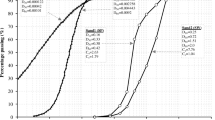Abstract
In the present study, the resistance features of sand–expanded polystyrene (EPS) and clay–EPS mixtures have been explored, using the direct shear box and unconfined compression test. EPS beads were mixed homogenously with sands in accordance with different mass ratios of beads to sands, i.e., 0, 0.25, 0.4 and 0.5%. Two various contents of EPS were used by clayey soil mass, i.e., 0.02 and 0.03%. In addition, two different sizes of EPS, coarse (d > 4.75 mm) and fine (d < 4.75 mm) were applied to reconstruct the samples. The experimental results indicated a decrease in internal friction angle and dilation in the sand, as well as in unconfined compressive strength (UCS) of clay samples with the increase of EPS percentage. In contrast, apparent cohesion in sand–EPS samples showed an increase. Moreover, specimens that were blended with coarse beads of EPS showed more internal friction angle, apparent cohesion, dilation and UCS compared with the samples were mixed with fine beads.













Similar content being viewed by others
References
American Society for Testing and Materials D2166 (1999) Standard test method for unconfined compressive strength of cohesive soils. ASTM Int., West Conshohocken, PA
American Society for Testing and Materials D3080 (1999) Standard test method for direct shear test of soils under consolidated drained conditions. ASTM Int., West Conshohocken, PA
American Society for Testing and Materials D422 (1999) Standard test method for particle size analysis of soils. ASTM Int., West Conshohocken, PA
American Society for Testing and Materials D4253 (1999) Standard test methods for maximum index density and unit weight of soils using a vibratory table. ASTM Int., West Conshohocken, PA
American Society for Testing and Materials D4254 (1999) Standard test methods for minimum index density and unit weight of soils and calculation of relative density. ASTM Int., West Conshohocken, PA
American Society for Testing and Materials D4318 (1999) Standard test method for liquid limit, plastic limit and plasticity index of soils. ASTM Int., West Conshohocken, PA
American Society for Testing and Materials D698 (1999) Standard test method for laboratory compaction characteristic. ASTM Int., West Conshohocken, PA
American Society for Testing and Materials D854 (1999) Standard test method for specific gravity of soils. ASTM Int., West Conshohocken, PA
Arellano D, Tatum JB, Stark TD, Horvath JS, Leshchinsky D (2010) A framework for design guideline for expanded polystyrene block geofoam in slope stabilization and repair. J Trans Res Board 2170:100–108
Bathurst RJ, Zarnani S, Gaskin A (2007) Shaking table testing of geofoam seismic buffers. Soil Dyn Earthq Eng 27:324–332
Deng A, Xiao Y (2008) Shear behavior of sand–expanded polystyrene beads lightweight fills. J Cent South Univ Technol 15(2):174–179
Deng A, Xiao Y (2010) Measuring and monitoring proportion-dependent stress–strain behavior of EPS–sand mixture. Int J Geomech 10(6):214–222
Duskov M (1991) Use of expanded polystyrene (EPS) in flexible pavements on poor subgrades. In: Proceedings of the international conference on geotechnical engineering for coastal development, Yokohama, pp 783–788
Elragi A (2000) Selected engineering properties and application of EPS geofoam. Ph.D. dissertation, State University of New York, Syracuse
Horvath JS (2005) Expanding the use of expanded polystyrene (EPS) geofoam in practice. In: Proceedings of the geotechnical engineering seminar (ASCE), Waltham, pp 7–80
Ikizler SB, Aytekin M, Nas E (2008) Laboratory study of expanded polystyrene (EPS) geofoam used with expansive soils. Geotext Geomembr 26(2):189–195
Koerner RM (2005) Designing with geosynthetics. Prentice Hall, Upper Saddle River
McDonald P, Brown PG (1993) Ultra lightweight polystyrene for bridge approach fill. In: Proceedings of the 19th Southeast Asian geotechnical conference, Singapore, pp 663–668
Negussey D (2002) Slope stabilization with geofoam. Report to FHWA and the EPS industry, Geofoam Research Center, Syracuse University
Negussey D, Sun M (1996) Reducing lateral pressure by geofoam (EPS) substitution. In: Proceedings of the international symposium on EPS construction method, Tokyo, pp 202–211
Wen Z, Sheng Y, Ma W, Qi JL (2008) In situ experimental study on thermal protection effects of the insulation method on warm permafrost. Cold Reg Sci Technol 53(3):369–381
Yoshizaka K, Sakanoue T (2003) Experimental study on soil-pipeline interaction using EPS backfill. In: Proceedings of the pipeline engineering and construction international conference, Baltimore, pp 1126–1134
Zou Y, Small JC, Leo CJ (2000) Behavior of EPS geofoam as flexible pavement subgrade material in model tests. Geosynth Int 7(1):1–22
Author information
Authors and Affiliations
Corresponding author
Rights and permissions
About this article
Cite this article
Shirazi, A.N., Haydarian, H. & Nasehi, S.A. Shear and Compression Behaviors of Sandy and Clayey Soils Mixed with Different Sizes of Expanded Polystyrene Beads. Geotech Geol Eng 36, 3823–3830 (2018). https://doi.org/10.1007/s10706-018-0575-y
Received:
Accepted:
Published:
Issue Date:
DOI: https://doi.org/10.1007/s10706-018-0575-y




